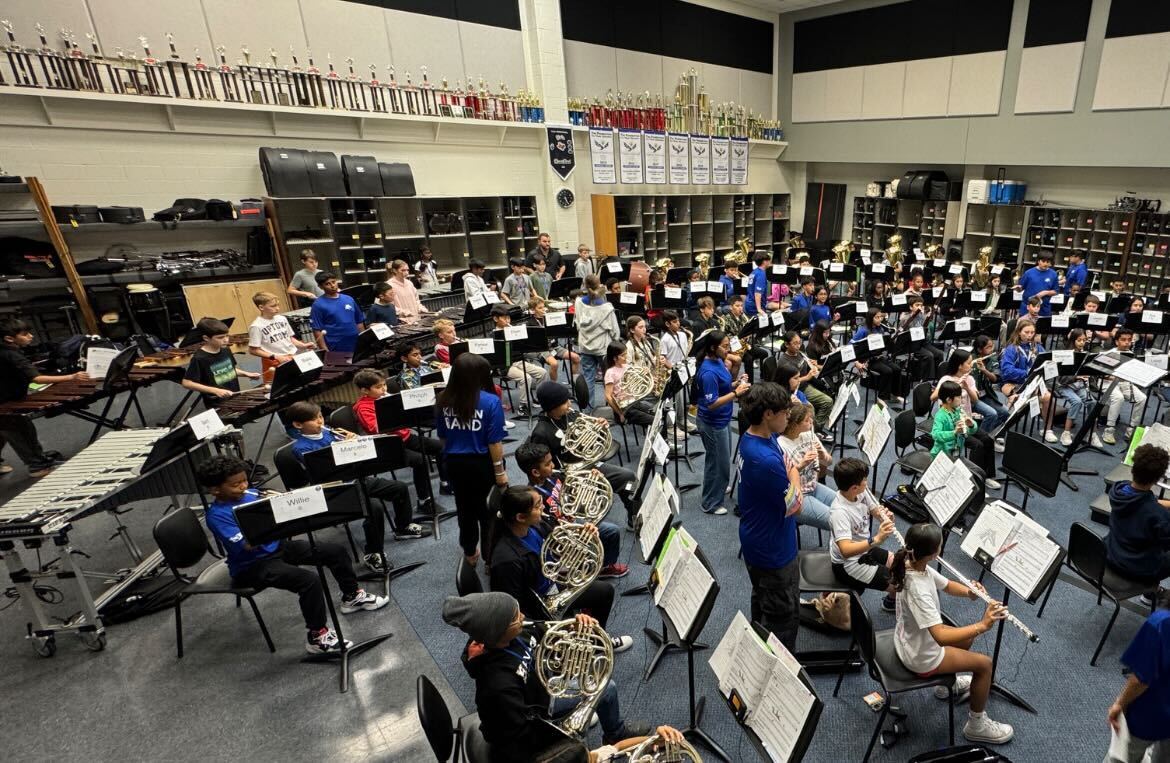If you walk into the band hall of any program with a long history of success, you’ll notice several similarities: engaged students, masterful teaching, and a well-organized rehearsal environment, to name a few. However, something far greater hiding beneath the surface makes all of this possible. One could even argue it’s the single most important aspect of any successful band program: planning.
Speaking from experience, everything we do at Killian starts with a plan. From the large-scale planning necessary for events and curriculum to the detailed planning of concert preparation and sequencing, every event, class, and procedure has a plan.
In this article, I discuss two areas where focused, thoughtful planning will immediately impact your band program: curriculum planning and concert cycle preparation.

Curriculum Planning
Unlike core subjects, it’s rare to walk into a band job and be handed a fully developed curriculum. At least, that was the case when I stepped into my first job over a decade ago. Do you mean to tell me I have to decide what concepts are important, when to introduce them, and how to teach them? Bonkers!
Scope and Sequence Document
No matter what it looks like for you, I strongly recommend that every band director have a curriculum scope and sequence document. I use a Google Sheets document with categories like Theory, Rhythm, Tone Production, and Literacy. On the left-hand side, I list the weeks, numbered sequentially, along with the corresponding date ranges.
With the template in place, I map out the entire year. I have separate tabs for beginners and our three competitive bands. This document is typically constructed over the summer, referencing the previous year’s version. Once the year begins, I add notes on what worked, what didn’t, and any adjustments I made.
If you don’t have a curriculum document, starting one might feel daunting. This was certainly the case for me during my first few years of teaching. To overcome this obstacle, here are a few suggestions:
- Start documenting everything you teach. It doesn’t have to be pretty! It can simply be a Google Doc that you keep open in your browser, where you can ‘brain dump’ your thoughts and ideas each week.
- If you work in a cluster, consider sitting down with your colleagues to discuss what topics they teach and when. This can be especially helpful if your cluster mates are more experienced teachers.
- Work with the end in mind. Create a list of what you want your last grade level of band students to know. Then, work backward through the other grade levels and decide when certain certain topics should be introduced and developed.
- Middle school directors should talk to high school directors, and vice versa. This is a team effort! If you’re a middle school director, your primary job is to prepare students for high school band. As a high school director, you should know what your middle school colleagues are teaching so you can pick up where they left off.
- Consult with private lesson staff, mentors, and clinicians. They all have a wealth of experience and insight to help you properly structure and sequence your curriculum for optimal learning. There are also countless books and articles written by amazing educators on this very topic.
Other Considerations
Once a curriculum is in place, creating your weekly lesson plans becomes much easier. I speak from experience! After I committed to developing and updating a curriculum for my program, lesson planning time was cut in half. Rather than starting from scratch each week, I could reference a timeline of content that kept me on track.
Curriculum planning also helps answer the age-old question: are my students behind or ahead of where they were last year? With past curriculum sequences to reference, you can answer that question concretely instead of relying on a ‘gut’ feeling. Additionally, if your students are behind or ahead compared to previous years, you have clues to help identify what led to that outcome.
Most importantly, building a curriculum helps keep your team on the same page. If multiple directors teach different segments of your band program, it’s crucial to ensure that all students are on the same page at the end of the year. Building a curriculum with your team is also a great way to foster strong relationships, collaboration, and investment among staff members.
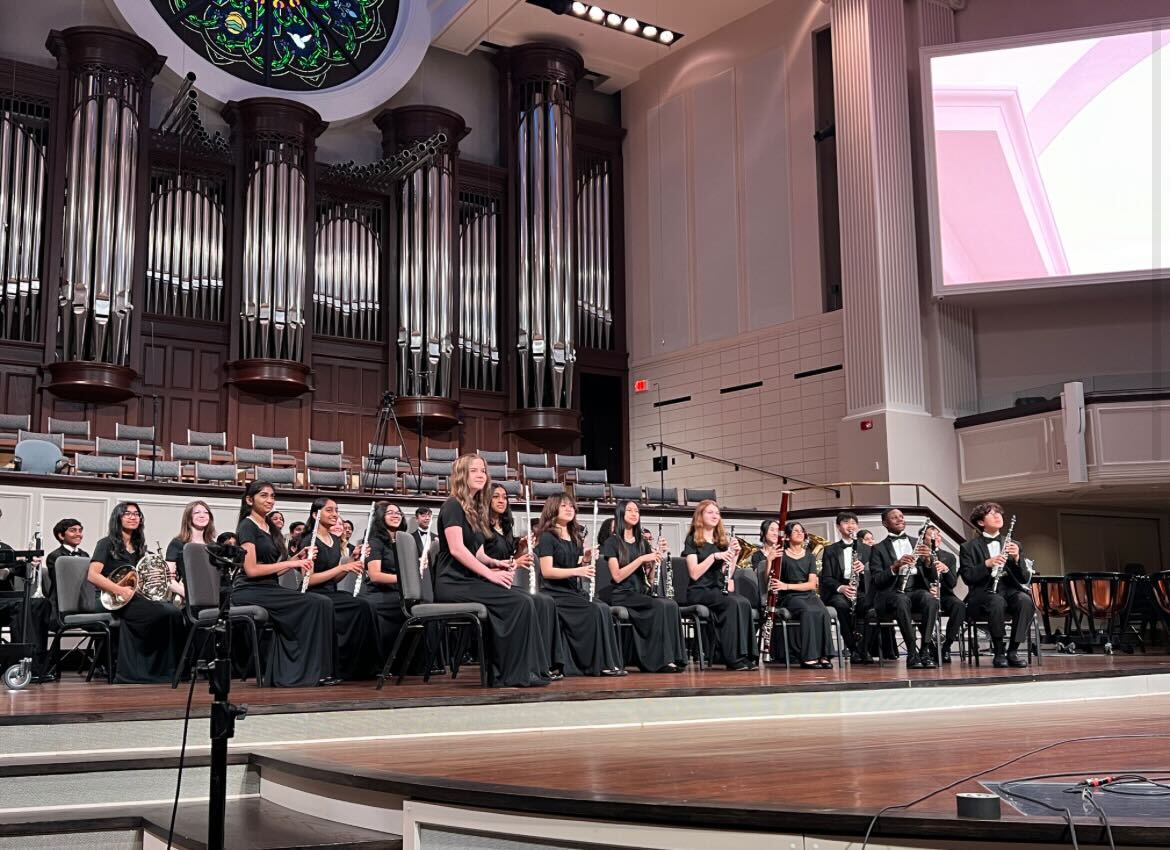
Concert Preparation Cycle
Whether it’s a Fall Concert, UIL, or the Spring musical, planning is critical in creating a memorable performance for your students and their audience. Once the music is chosen and the timeline is set, how do you ensure that every measure of music is taught and refined?
Score Study
After selecting music for a concert cycle, the next step is score study. This should be done before any music is distributed. Everyone’s process for score study is different. I do all of my annotating and marking in GoodNotes on my iPad. After scanning a high-resolution PDF of my score, I import it into the app and begin marking, highlighting, and annotating.
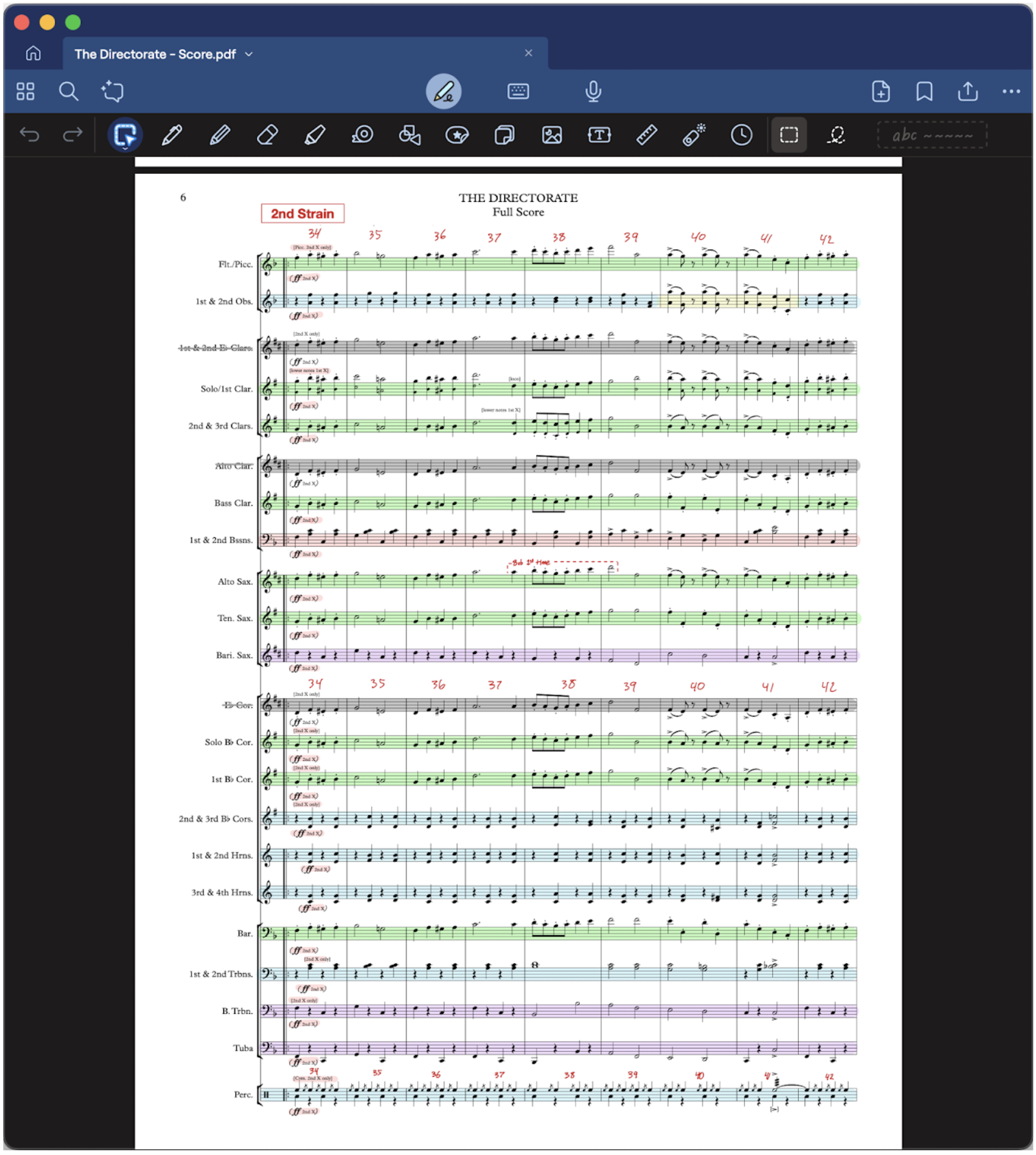
This process allows me to become comfortable with the music and identify potential learning pitfalls. I also use this time to ‘chunk’ the music, a step that will be useful later. I share my annotated scores with my mentors, lesson staff, and even my students. That way, everyone involved benefits from my work and study.
The Overlapping Chunks Method
Once score study is complete, the next step is to plan how you will introduce the music. The best piece of advice I was ever given in this area came from my first mentor, Marty Nelson. I’ve dubbed it the “Overlapping Chunks” method. Here’s how it works:
- Determine how many weeks you have to prepare the music for the performance. Subtract one week as a ‘buffer.’
- Take the number of weeks you have and divide your music into the same number of chunks. Make sure each chunk is manageable and can be taught within a week. Depending on your band’s skill level and the music, the chunks may vary in length. More complex chunks may consist of only a few measures, while easier chunks may cover many more.
- Overlap your chunks between sectionals, rehearsals, and assessments.
Here is a template for this process:

Here is an example of a plan I am using this year with our non-varsity band:
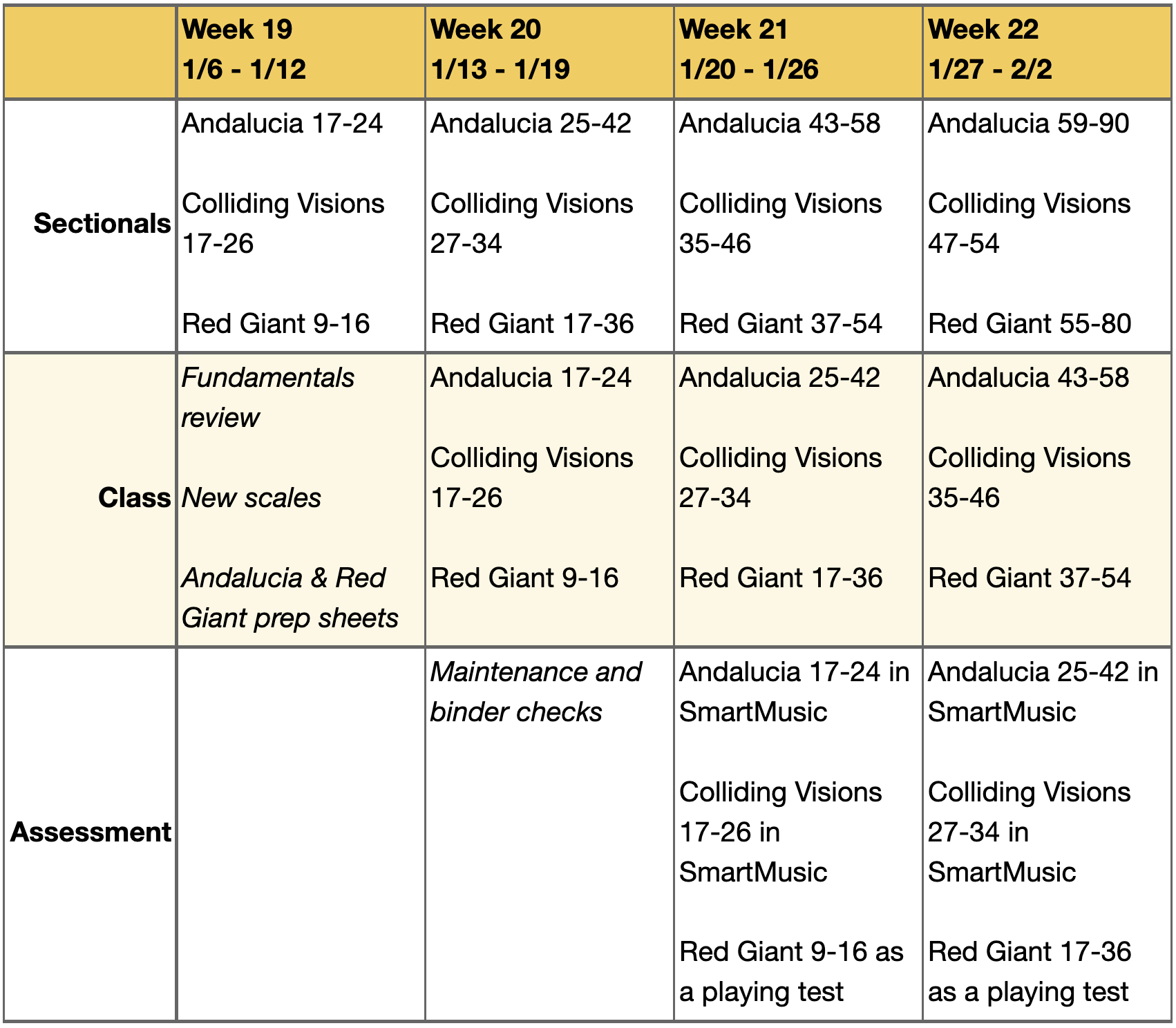
You may also notice that I used the first week of rehearsal to review fundamentals, add new scales, and use ‘prep’ sheets based on the upcoming music.
Additionally, chunks don’t have to be introduced in sequential order. With more challenging literature, I often introduce music chunks out of order, based on difficulty. The most difficult chunks are introduced earlier in the preparation timeline, leaving the easier chunks to be introduced later. This approach gives your students the most time to work on the music that needs it the most.
Tempo Planning
In conjunction with your chunks, you should also create a tempo plan to gradually increase the tempos of your selected pieces, from slower learning tempos to faster performance tempos. To do this, start with your target performance tempo. Then, set your initial learning tempo at a level appropriate for your ensemble. Take the total number of weeks and plan incremental tempo increases until you reach the goal tempo.
Here is an example of a tempo plan I am using for my march this year with our varsity band:
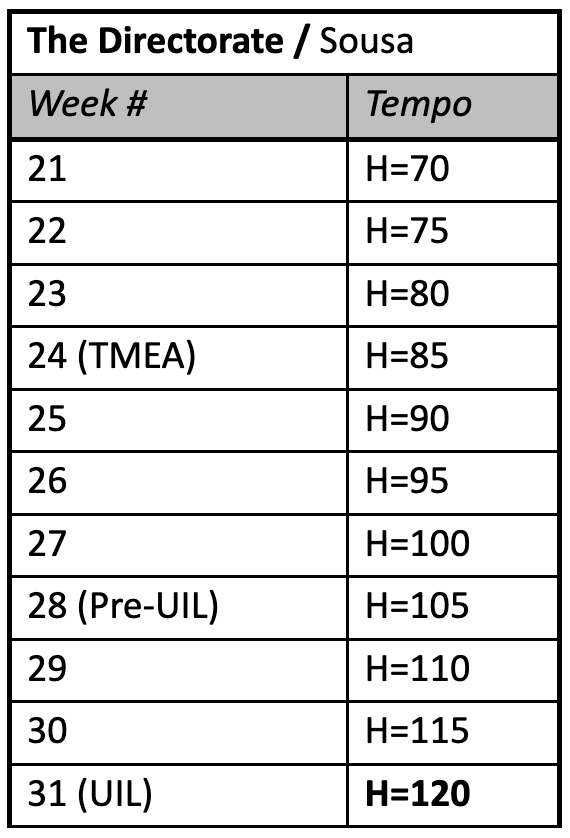
Weekly Rehearsal Planning
Once you’ve created a chunk and tempo plan, it’s time to incorporate them into your weekly rehearsal planning. Similar to overlapping different chunks of music, you can also overlap your individual pieces each week.
For example, if your concert cycle consists of three pieces, it’s best to tackle two of them each rehearsal, especially if you have 45 minutes or less for each class period. Each day, start with the piece you ended with the day before. Repeat this process daily to ensure that no single piece is overlooked for too long.
Here is an example using the non-varsity chunking plan mentioned previously:

You may notice that Friday includes a ‘run’ of each piece, incorporating previous weeks’ chunks and previewing next week’s chunk. This keeps the music fresh and provides an opportunity to record the rehearsal for later review. Thursdays are also a good day to incorporate sight-reading, especially if you’re preparing for adjudication. Additionally, reserve some rehearsal time as a buffer in case of an interruption earlier in the week or if a chunk needs more class time to be fully put together.

Conclusion
In conclusion, effective planning is the cornerstone of any successful band program. Whether it’s developing a comprehensive curriculum, carefully structuring concert preparation, or strategically managing your rehearsal time, thoughtful planning ensures that every element of your program runs smoothly and efficiently. By breaking down your music into manageable chunks, creating a tempo plan, and overlapping pieces in your weekly rehearsals, you can ensure consistent progress and a focused approach. The key to success is collaboration—whether with colleagues, mentors, or students—and continuously refining your approach to best meet the needs of your ensemble. With dedication to planning and intentionality in execution, you’ll create a musical environment where students can thrive and performances are sure to shine.


